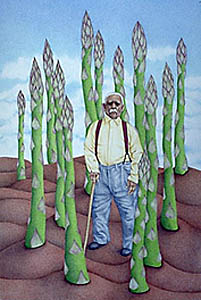From tools to 'Totems'
These towering, haunting presences combine found objects and fabricated elements in ingenious ways. The central image of most is a tall trunk made to resemble the handle of a hammer. This elegant, slightly undulating form suggests a number of references, King notes. Among them are the female figure, a Coke bottle, the body of a jet aircraft, and the shape of Chinese vases or Egyptian urns. Each has a head in the form of an object that symbolizes the totem's spiritual nature, and most are set on tables from which found objects sometimes dangle.
King and his wife, Melani McKim, whose paintings and drawings also are on view at the gallery, collect tribal art, which has influenced his work deeply. "Yukon Sentinal" and "Arctic Monolith," for example, derive their forms from Inuit art. The masklike head of the former and ovoid head of the latter are encircled with haloes, a common element in Inuit art. Each has a kind of gridlike aura that moves down the body, suggesting, perhaps, an exposed rib cage made of crude, bonelike dowels.
African nail fetishes from the Congo serve as a source for several pieces. "Brancusi's Fetish," for example, juxtaposes an ostrich egg with a wrapped and abraded body into which nails have been driven at the waist. The piece pays homage to Brancusi and other European artists who were influenced by tribal art when it first was brought to Europe in the early part of the century.
David King "Totems" and Melani McKim "Fictional Scenes From Life"
At b. sakata garo, 923 20th St. Noon to 7 p.m. Tuesdays- Saturdays. Through Oct. 6. (916) 447-4276.
Images from Southwestern Indian cultures inform "Zuni Kachina Fetish," which rises up from a base resembling the head of a kachina doll and terminates in a form that resembles a pitchfork. Those images also are present in "Santo Domingo Fetish," which pays homage to Pueblo Indian peoples and incorporates moose antlers.
In addition to Brancusi, King pays tribute to Marcel Duchamp in a witty, surreal piece that places a bicycle wheel atop the hammer shaft; and to Mark Rothko in "Dutch Me Ball Me," a playful piece in which a lawn bowling ball is placed atop a shaft painted in vibrant colors that echo the stratification of diffused colors that Rothko employed in his abstract paintings.
"Leda's Myth," perhaps the most elegant piece in the show, hearkens to classical Greek culture. Leda, you will remember, was ravished by Zeus in the guise of a swan. King's sculpture places a wooden decoy of a swan's head made by his father atop a gorgeous, undulating piece of wood that sits on an elegant, classical table. It's spectacular.
McKim's drawings and paintings are meticulous, precise images that place figures derived from antique photographs in surreal settings.
"Dwarf and Young Girl" is a disturbing, Diane Arbuslike image of an odd couple in a spare room with an arched niche in which sits a dead plant. "Meat" is a rendering of a baby in a red room with a window that looks out on a billboard on which the word "meat" is painted. "Rat Boy" is an image of a young boy with a huge dead rat on a street that might have been lifted from one of Giorgio de Chirico's paintings.
Family photos also play a part in her work. "114 Year Old Asparagus" is an image of David King's great-grandfather, an asparagus farmer who lived to be 114, standing in a field of towering green spears. In "Self-Portrait of the Artist in a Box," she works from a photograph of herself placed in a sarcophaguslike box set in a field of surreal, breast-shaped hills.
The strongest piece in this body of work is "Barren Trees," a smooth oil painting on gessoed board of a woman and child in a landscape of dreamlike, archetypal earth forms with a barren tree in the background and a shelf with enigmatic objects in the foreground. It has a frozen, fearsome quality that gives it an unsettling edge.
| ||||||||||||||||||||||
